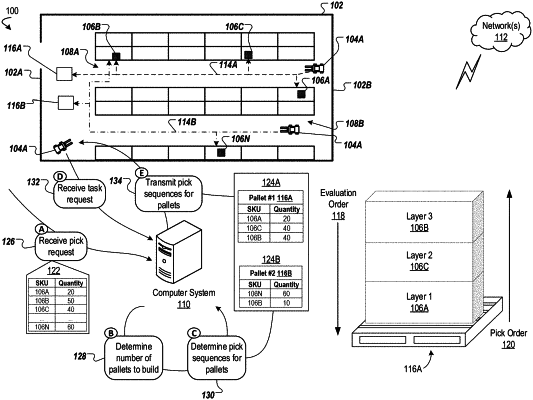| CPC G06Q 10/0875 (2013.01) [G06Q 10/06316 (2013.01)] | 20 Claims |

|
1. A method for determining a pallet build sequence in an automated warehouse, the method comprising:
receiving, by a computing system, a pick order request, wherein the pick order request includes a list of items to be picked and a quantity of each of the items to be picked;
identifying, by the computing system and based on the pick order request, candidate pick items in the automated warehouse that can be used to fulfill the pick order request;
grouping, by the computing system, the identified candidate pick items based on aisles;
generating, by the computing system, aisle-based lists for each of the groups of identified candidate pick items;
sorting, by the computing system, each of the aisle-based lists based on a location of each of the identified candidate pick items in each of the groups relative to a front of the automated warehouse, wherein a first candidate pick item closest to the front of the automated warehouse is put at a top of the aisle-based list;
iteratively performing the following for each of the aisle-based lists:
selecting, by the computing system, a first candidate pick item at the top of the aisle-based list;
adding, by the computing system, the first candidate pick item to a bottom layer of a pallet;
retrieving, by the computing system, strength information of the first candidate pick item;
determining, by the computing system, an amount of weight of candidate pick items from the aisle-based list that can be layered on top of the first candidate pick item;
determining, by the computing system, whether the first candidate pick item is able to support the determined amount of weight based on the determined amount of weight being less than the strength information;
in response to determining that the first candidate pick item is able to support the determined amount of weight, keeping, by the computing system, the first candidate pick item in a pick sequence as the bottom layer of the pallet and removing the first candidate pick item from the aisle-based list; and
in response to determining that the first candidate pick item is not able to support the determined amount of weight, removing, by the computing system, the first candidate pick item from the pick sequence as the bottom layer of the pallet and keeping the first candidate pick item on the aisle-based list;
generating, by the computing system, pallet build instructions based on the pick sequence for the aisle-based list, wherein the pallet build instructions indicate that a subset of the layers of the pallet have a same build order permitting them to be assembled at interchangeable positions within the pallet when building the pallet according to the pallet build instructions; and
transmitting, to an automated layer picker, data representing the pallet build instructions that, when executed by the automated layer picker, cause the automated layer picker to automatically perform operations that include (i) moving to an aisle in the automated warehouse that has a relationship with the aisle-based list, (ii) picking items in the aisle based on the pick sequence for the aisle-based list, and (iii) assembling the picked items on the pallet based on a set of coordinates in the pallet build instructions that indicate locations on the pallet where each of the picked items should be placed,
wherein the strength information includes a maximum weight load that the first candidate pick item can support without being crushed, wherein the maximum weight load is determined, by the computing system, in a process comprising:
determining a supplier-provided load on a bottom layer of a pallet having the first candidate pick item, wherein the supplier-provided load is a weight for each layer multiplied by one less than a number of layers on the pallet; and
determining the maximum weight load based on applying a margin threshold multiplier to the supplier-provided load.
|